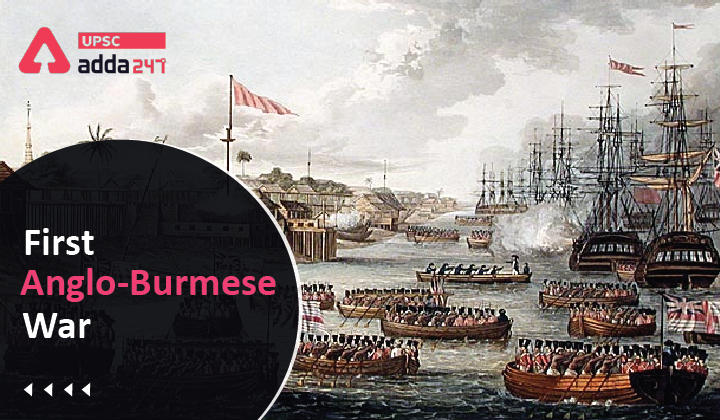Table of Contents
Anglo-Burmese War- Relevance for UPSC Blog
- GS Paper 1: Indian History– Modern Indian history from about the middle of the eighteenth century until the present- significant events, personalities, issues.
Background of Anglo-Burmese War
- British India and rulers of Burma fought many wars between 1824 to 1885 before which British supremacy was established over Burma in 1886.
- First Anglo-Burmese war was the beginning of the Anglo-Burma Conflict.
- Rule of Konbaung Dynasty: It ruled over Burma (Present-day Myanmar) from 1752 to 1885.
- Failed adventure in Thailand: Konbaung Dynasty unsuccessfully tried to attack and annex Siam (Ayutthaya Kingdom) in modern Thailand during 1765-1769.
- The Ayutthaya Kingdom pleaded China for help and Qing Dynasty waged a war against the expansionist Burmese rulers.
Causes of the First Anglo-Burmese War
- Aspirations of Konbaung Dynasty: After failure in Thailand, Burma shifted its focus westward towards Arakan (Present day Manipur area).
- The Arakan was the eastern frontier of Bengal which was fairly independent since Mughal Period.
- The Burmese forces of king Bodawpaya entered Arakan and captured modern Manipur in 1813 and Assam in 1817-19.
- Now Burma Kingdom came face to face with the Britishers as they now came close to the border of the Bengal.
- Ill-Defined Border: Lack of clarity on the border between British India and Burma combined with the expansionist mindset of both parties led to frequent conflict between them.
- The pretext of border dispute was used by both to justify their expansionist aspirations, leading to the First Anglo-Burmese war.
Warren Hastings | First Governor General of Bengal
Course of the First Anglo-Burmese War
- Lord Amherst came to India as governor-general of the Company in 1823 who decided to invade Burma in February 1824.
- Previously a conflict emerged over the possession of the island of Shahpuri which was under the Possession of the English.
- The Burmese attacked and captured the Shahpuri island for some time before returning it to the British.
- However, this did not satisfy Lord Amherst who was looking for an excuse to attack Burma.
- Two Front war: The English attacked Burma from two sides.
- One army proceeded through land-route of the north-east.
- The other army attacked Rangoon from the side of the sea.
- Jungle Warfare: The English faced heavy odds in the jungles of Burma. This was aggravated with the beginning of the rainy season.
- The Burmese commander, Maha Bundela, defeated the English at Ramoo near Chittagaon.
- But, in the south, the English easily captured Rangoon in May 1824.
- Maha Bundela was recalled by the king of Burma in the south. He, however, was defeated by the English in a battle on December 15, 1824.
- Capture of Assam and Lower Burma: The English conquered Assam in 1825 and moved forward from Rangoon.
- The English occupied Prome, the capital of lower Burma.
- Negotiation for Peace: The skilled Burmese commander, Maha Bundela was killed in a battle in 1825, forcing Burma to seek peace with the Britishers.
- The Burmese started negotiations for peace when the English were only sixty miles away from Yandabo, the capital of Burma.
- This resulted in the Treaty of Yandabo in 1826.
Treaty of Yandabo
- The treaty of Yandabo was signed by the two parties in February, 1826.
- Key terms of the Treaty of Yandabo:
- Burma gave up all its claims over Assam, Cachar and Jaintia.
- It surrendered Arakan, Yeh, Tavoy, Mergui and Tenasserim to the English.
- It accepted Manipur as an independent state and agreed to acknowledge Gambhir Singh as its ruler.
- It agreed to pay a war indemnity of rupees one and a half crores to the English.
- Both parties accepted each other as friends, agreed to depute and receive each other’s ambassadors and also to enter into a commercial treaty.





 TSPSC Group 1 Question Paper 2024, Downl...
TSPSC Group 1 Question Paper 2024, Downl...
 TSPSC Group 1 Answer key 2024 Out, Downl...
TSPSC Group 1 Answer key 2024 Out, Downl...
 UPSC Prelims 2024 Question Paper, Downlo...
UPSC Prelims 2024 Question Paper, Downlo...
